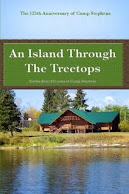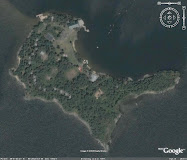 |
| Jim Leggat |
At the end of the summer in 2006 family of former camp director Jim Leggat and close friends gathered at Camp Stephens at the place where Y's Men once stood. The first cabin on the line had been replaced with a new one, named Leg's Place in his memory.
Leggat died suddenly Nov. 11, 1994 at age 41 while hiking in British Columbia.
Here are the words spoken that day.
They and the photos were provided by Leggat's sister Carolyn Schram and his brother John Leggat.
Speaking is former camp director Grant Platts:
Camp Stephens - August 26, 2006
I was honoured when Carolyn asked me to say a few words today about Jim and his history at camp.
Jim started Stephens as a camper in 1968 -- at the somewhat advanced age of 15. Apparently he was not all that keen to go the first time, but once he got there, he was bitten by the bug. Not only was Stephens a major part of his life for the next 11 years, but it also provided the foundation for his lifelong career in camping.
After his first year as camper, Jim followed in 1969 as a counsellor-in-training (CIT) under the leadership of Brian "Stubby"Law. Included in that group were a number of guys (including Jim, Neil Robinson, Jamie Grant and Mike Pawluk) that went on to play major roles at Stephens in the resident and wilderness programs throughout the next number of years.
Jim was a counsellor and canoe tripper during the early 70s culminating in his leading the fourth ever boy's six week trip in 1973. That trip was perhaps the most remote and challenging ever, a route that started in South Indian Lake and travelled the length of the Seal River into Hudson Bay, north of Churchill, Manitoba.
During the next few years Jim was back in camp as a section director and canoeing specialist. Winters saw him working at Kinsmen Lodge at the Y's Camp Manitou.
In 1977 Jim was appointed director of Stephens where he remained for the next three years. His last summer was 1979 after which he accepted a position with the Victoria YM-YWCA as the director of Camp Thunderbird, where he remained until his untimely passing.
During his time as Stephens' director, Jim made a number of positive changes. Among the more notable was the lengthening of the girl's invitational trip from four to six weeks and the change from one tripper and five participants to the current two and seven ratio, a move that significantly reduced risk, but one that was not altogether met with open arms by the macho men of the woods.
Jim's sudden death in 1994 came as a shock to his family who lost a beloved son, brother and uncle, and also to all of his friends. After Jim's funeral, a suitable wake was held in his honour at the Victoria Inn in Brandon. Jim would have been proud.
I'd like to finish by reading messages sent by two of Jim's closest friends.
The first is from Neil Robinson:
When I first met Jim Leggat as a CIT he was solid with large and extremely strong legs. Also, given the fact that his last name was Leggat, he was quickly known as "Legs" around camp. Everybody knew who Legs was, campers and staff alike. Whether Jim was a camper, CIT, counsellor, section director, canoe tripper or camp director, he truly loved camp and each winter looked forward to getting back to Stephens.
Legs loved dealing with everyone at camp and could be seen tilting his head back and roaring with laughter, or, with a twinkle in his eye, make a joke and giggle. I've never met a large man that could giggle so well.
One of my favourite recollections is of Jim as the camp director. Picture this: Big Jim, likely having a cigarette in his director's cabin, and then ringing the camp bell early in the morning to signify the daily camp run and polar bear swim. A group of 20 junior campers (Junies as they are called) are dwarfed by the fearless leader Legs. After an appropriate warm-up of two jumping jacks and three pushups, the group is off and jogging. Around the island they go in a line behind their leader, with Jim cracking jokes and making every Junie feel welcome. The polar bear swim is a welcome relief for the Junies and their overheated leader Legs.
Other than Jim's fun side, which was huge, there was a dedication to make camp a better place. He made positive changes to the tripping program and to camp life and believed in the ideals of the YM-YWCA.
It is an honour to have know Legs and to have a cabin named after him. When I am back on the island, I will go there first.
And finally, this tribute from Jamie Grant:
One of my more vivid memories of Legs is of the day he and his six-week crew returned to Stephens from their trip down the Seal River. In keeping with his character his presence that day was again larger than life. His presence and his calm permeated the crowd gathered that afternoon. His stories of their travels captivated everyone present. I remember hanging onto every word of their adventure. I felt like a kid listening to a great storyteller. That was his day. His ever-present smile with a chuckle was replaced with a sense of serious reflection. However, that twinkle in his eye was ever-present.
To me, the experience of that trip and what he was able to see in himself initiated a belief and created a stepping stone that eventually led him to become director of Camp Stephens and later Camp Thunderbird.
He understood what it was to be a leader and decision maker, how to teach and influence others... how to build a team. You could see it flow from his six-week group that afternoon and subsequent evening. He was proud of his ability to influence others. I believe he had learned that he had certain skills tucked away under the carefree character of his that he may not have known he possessed. He could now move forward on his own terms... which he certainly did.

I paddled that same route as Legs and his group had down down the Seal River about eight years later. We came across a cabin close to a set of rapids where we stopped for lunch. On the wall was a note written by Legs and his group. I added a follow-up note to their etching on the wall. All I could really write was, "the Spirit of those that have preceded us prevails". I was thinking 0f Jim as I wrote. His spirit was ever-powerful as I sat at that table in the cabin that day. It is now once again overwhelming as I write this note... and I am sure it is the same with all of you gathered today for this dedication to Legs.
I wish I could be there today. Sorry I cannot.
My best wishes to Marion Leggat and to all members of the Leggat family.
Jim was a wonderful friend and I miss him. His Spirit continues to prevail ever so strong!























